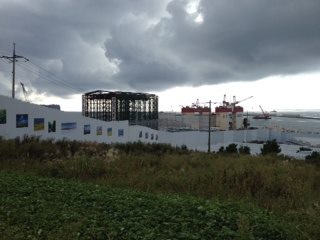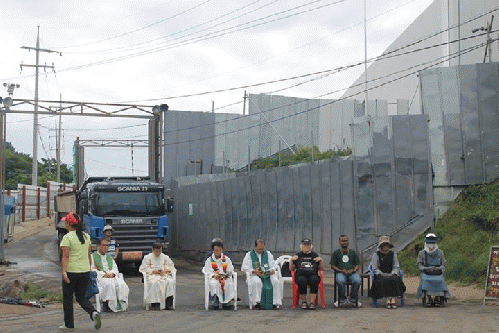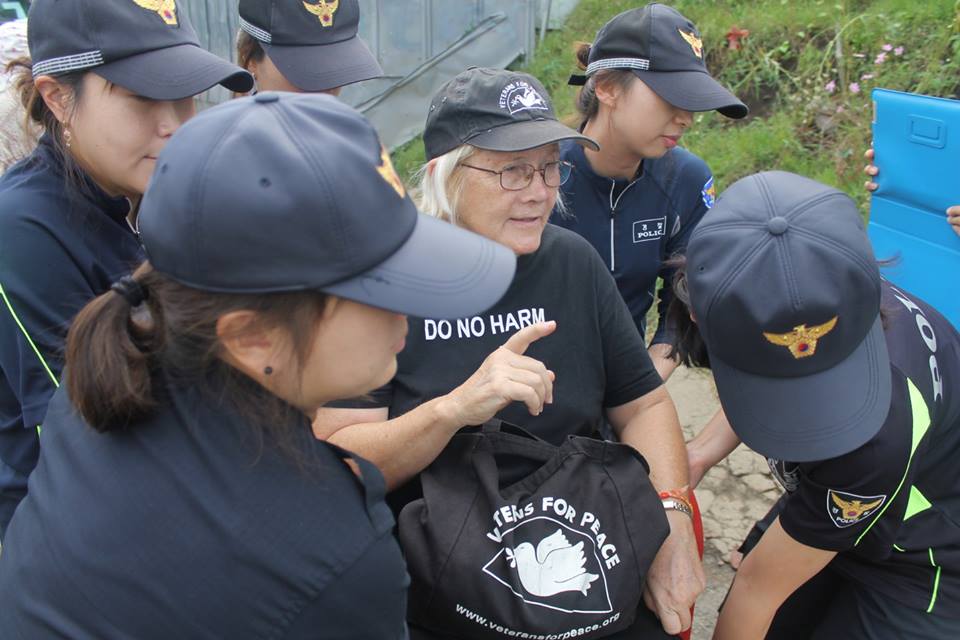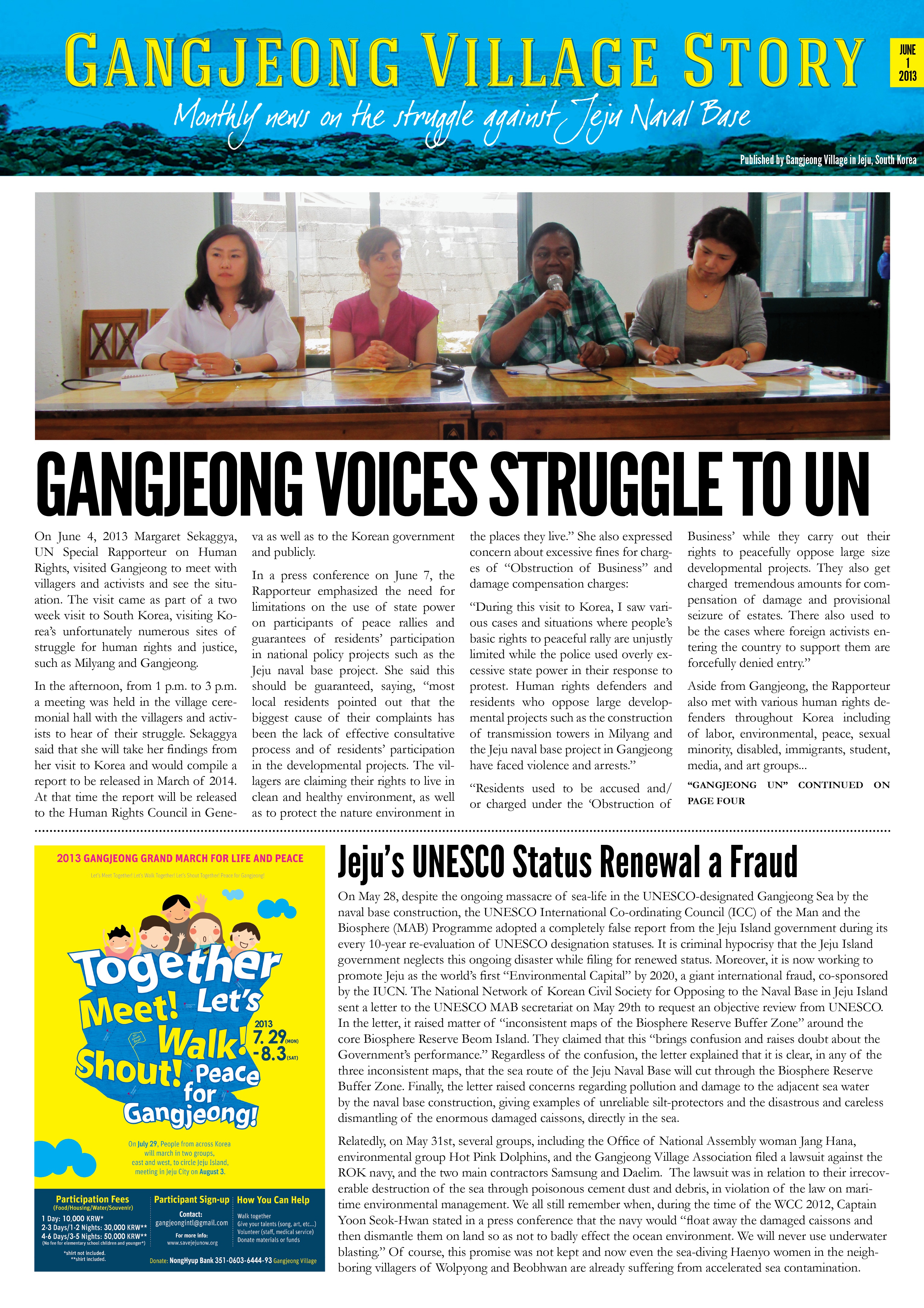In this month’s issue:
100,000 Books arrive in Gangjeong for the creative transformation to a “book village”, National Assembly inspections on the base, Solidarity from Italy and Western Europe, Gangjeong at the Busan WCC Assembly 2013, Trial updates, outrageous imprisonments, police disrupt prohibit catholic Eucharist and more!
Save Jeju Now
No War Base on the Island of Peace
Tag: civil disobedience
-
Jeju Island: Tragic Destruction of Pristine Marine Area for Another Naval Base for the US Missile Defense System
Two years ago when I visited Gangjeong village on Jeju Island, South Korea, the one-half mile ancient, solid volcanic slab of a spiritual and cultural rock known as Gureombi was still intact. The marine environment that had made Jeju Island one of the World Heritage Sites was still thriving with sea life. The government of South Korea had moved some equipment to be used for construction of a controversial naval base for Aegis missile destroyers and the US missile defense system. This would be a new military port in a country filled with US and South Korean military installations, but one that would be just a little bit closer to China–a new naval base that would symbolize the US pivot toward Asia and the Pacific.
Plane loads of protesters from the mainland of South Korea were flying to Jeju to join villagers to prevent the construction of the naval base. Hundreds of internationals came to add their words of solidarity and to take back the story of a tiny village challenging the might of the governments of the United States and South Korea in their quest for greater militarization of both societies.
Two years ago, trucks carrying materials for the new naval base to be built on the rocks were delayed or stopped by protesters. NO BASE supporters climbed on top of high cranes and chained themselves to heavy pieces of equipment to stop construction of the base.
I returned this week to Jeju Island in solidarity with the people of the village of Gangjeong who did not want their home turned into a military encampment that would destroy their way of life. Yet, despite seven years of opposition and struggle, the naval base and its harbor have been substantially constructed. Hundreds of thousands of tons of stone have been dumped on corals to make the breakwaters for the harbor. Thousands of massive concrete structures are on the shore. Two giant structures have been erected in the water that produce cassions for the massive breakwater that might protect the military harbor from typhoons. The beautiful rocks of Gureombi have been broken apart and the area filled with concrete. It is an environmental disaster.
This week, the edge of a typhoon hit Jeju Island. Many here in the village of Gangjeong were praying for a strong storm that would severely damage the naval base as happened last year that caused over $35 million in damage to the project. Perhaps Mother Nature would intervene to stop the construction when humans were unable to do so.
Many activists who opposed the base have gone to jail in the past two years. 5 are currently in jail. Earlier this week, two more were sentenced to lengthy terms in prison- a young 22 year old woman received a sentence of 8 months and a 72 year old was sentenced to 6 months. A filmmaker has been in prison for 253 days and two others for 103 days each. A trial for two more is scheduled for this week. The South Korean government crackdown on protest of the naval base has been strong.
Yet every day, a group of activists continue their challenges to the base–some challenges are spiritual and others are physical. On the spiritual side, at 7amthey gather outside the gate of the base and do 100 deep bows, each with a phrase set to music to remind participants of the importance of their mission. At11am, Catholic priests, nuns and lay persons lead a Mass at the gates. Masses have been conducted thee each day for over 740 days.
Following the Mass, for the next hour the group blockades the main gate of the naval base stopping trucks filled with concrete and other materials from entering the base and preventing empty trucks from leaving the base. The activists believe a disruption of an hour’s work in the building of the base is useful and important.
Special events are marked with larger mobilizations. In August, 2013, many walked for six days around Jeju Island and one thousand people participated in the Grand March for Life and Peace and the Human Chain to encircle the base. Noted film maker Oliver Stone joined in the march. When asked about his opposition to the base Stone said, “This base will host US Aegis missile destroyers, aircraft carriers, nuclear submarines. It’s part of Obama’s Pacific pivot…put in place to threaten China…We have to stop this. All this is leading up to a war, and I’ve seen war in Asia. I do not want another war.”[1]
Tension in Gangjeong village is high. Families have split on support or opposition to the base. Those in the village and in the provincial government who were paid off by the South Korean Navy not to oppose the base, as two other communities on Jeju Island had done, are in disfavor with many in the village. Having been defeated twice, the Navy decided to have a major campaign to influence the decision makers in the province and Gangjeong village. Decision makers succumbed to the temptations of fully paid trips to Hawaii, Australia and Singapore and other special benefits. Farmers in the village were pressured into selling their lands with the threat that if they didn’t accept the price offered by the Navy, the lands would be taken anyway and much lower compensation given in that case.
The lessons of Jeju Island are stark. The US military pivot to Asia and the Pacific will be disastrous for many areas—bases in Okinawa where the US wants to build a runway into the South China Sea over pristine corals, home to the dugong manatee; in Pagan, an island in the Northern Marianas where the US wants to use as a bombing range as it did for decades on the Hawaiian island of Kahoolawe and the Puerto Rican Island of Viequez; and in Guam where the Marines want to have an artillery range in an environmentally protected area.
With the pivot, the United States has increased its military exercises in the area. Current American military exercises with South Korea and Japan have triggered the North Korean government to put its military on alert and warned that these exercises could have “disastrous consequences.”
China is upset about US-Philippines military exercises in the South China Sea.
The Japanese people are angry that the US is urging the government of Japan to renounce the “No War” article of their constitution so the US will have another financial ally in wars of choice.
So far, just as the US pivot to the Middle East twelve years ago destabilized the region, the US pivot to Asia seems to already be having the same dangerous effect.
About the Author: Ann Wright served 29 years in the US Army/Army Reserves and retired as a Colonel. She was a US diplomat for 16 years and served in Nicaragua, Grenada, Somalia, Uzbekistan, Kyrgyzstan, Sierra Leone, Micronesia, Afghanistan and Mongolia. She resigned in March, 2003 in opposition to the war on Iraq.
Links:
[1] http://savejejunow.org/wp-content/uploads/2013/09/Gangjeong-Village-Story_Aug-2013.pdf
*Reblogged posts do not necessarily reflect the opinions or views of Save Jeju Now
-
3rd Jeju DMZ Peace Island Meeting to be Held in Moseulpo

Korean banner for the 3rd meeting. Tomorrow, August 15, 2013, the 3rd meeting of the movement to demilitarize Jeju “Jeju, the Demilitarized Peace Island” will meet. This meeting open to everyone will take place from 10 a.m. to 3 p.m. in Moseulpo, on the southwest cost of Jeju.
Moseulpo is an important place in the history of military and anti-militarist struggles on Jeju. During the Japanese colonization, the residents were forced to large caves out of the coastal cliffs of Mt. Songak to store torpedos to be used for attacks on allied forces in WW2, a part of Japans broader massive military build up of Jeju in anticipation of a stand off that fortunately never happened. Nearby is the abandoned Alddreu Airfield, also set up by the Japanese military for bombing China.

Caves along the cliff face of Mt. Songak. Later during 4.3 and Korean War, Moseulpo, like most of Jeju was also the site to several massacres including the Massacre at Seotal Oreum. In 1950, The Moseulpo Police had arbitrarily detained 344 people in the police station, a fishing storage, and a potato storage. 211 of the detained were eventually slaughtered without any legal process and secretly buried. 20 people were killed on July 16 and 193 on August 20. 41 other people went missing.
Later from 1987-1989, the Korean government attempted to build an air-force base on Mt. Songak, but strong local resistance won after a two year struggle and the plans were scrapped. However, the Korean Ministry of National Defense still owns land in the area and recently there was has been rumors that they again plan to build an airfare base there, perhaps on part of the old Alddreu Airfield (part of which has been declared a national heritage site). Meanwhile, the ROK MND has a small radar base in Moseulpo, formerly the U.S. owned Camp McNabb (for 53 years until it was taken over by Korean in 2005.

Moseulpo Radar Base, formerly U.S. Camp McNabb. In light of this history of oppression and resistance, Moseulpo is a key location for the movement to demilitarize Jeju.
Peace loving people from across Jeju and Korea will come together to tour the historical sites, hear about the successful struggle against the air-force base and discuss and plan the demilitarization of Jeju. Join us!
Contact gangjeongintl@gmail.com for for details.
-
UN Special Rapporteur on Human Rights Visits Gangjeong
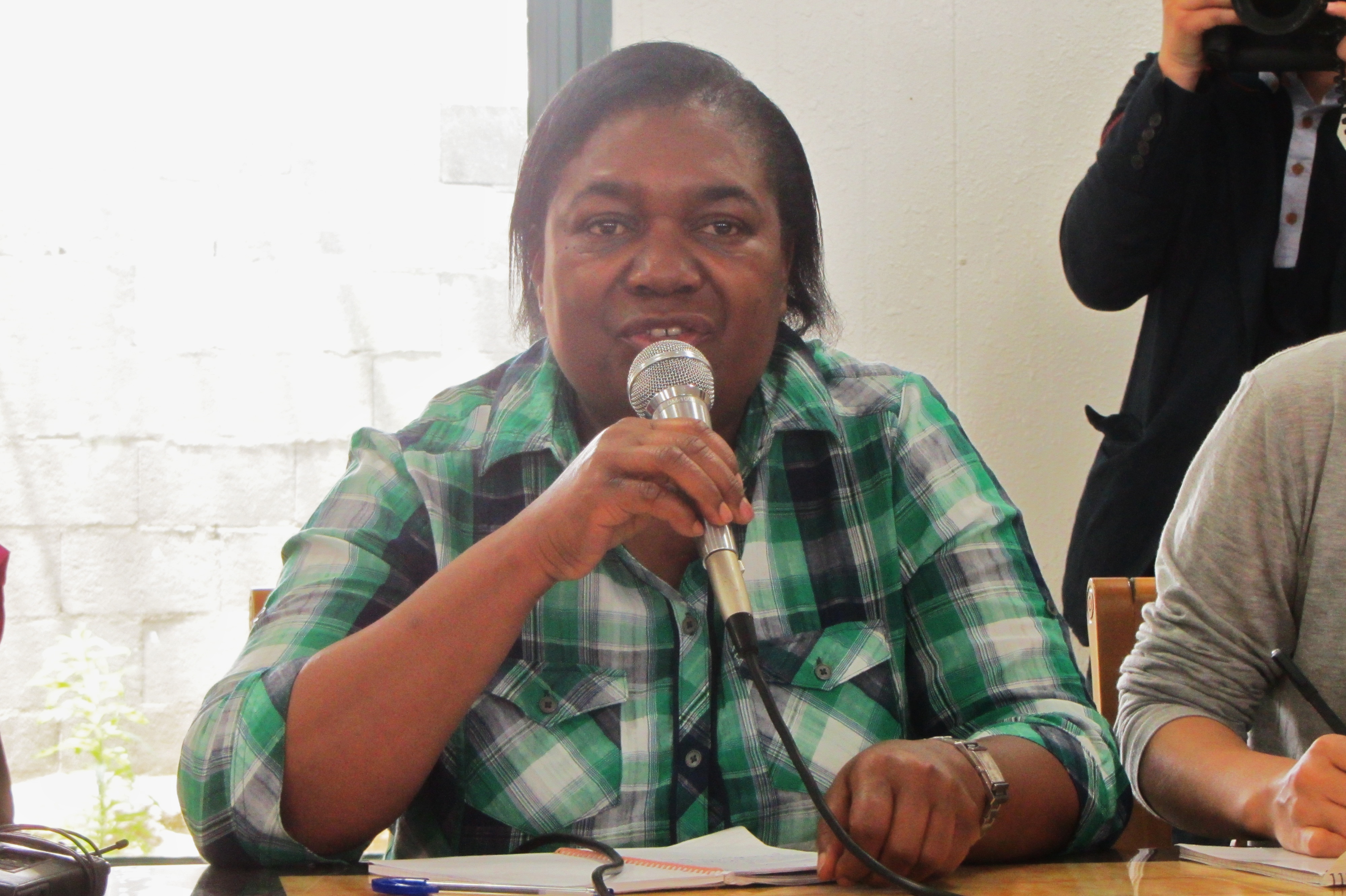
Margaret Sekaggya, UN Special Rapporteur on Human Rights, Introduces herself to Gangjeong residents. On June 4, 2013 Margaret Sekaggya, UN Special Rapporteur on Human Rights, visited Gangjeong to meet with villagers and activists and see the situation. The visit came as part of a two week visit to South Korea, visiting Korea’s unfortunately numerous sites of struggle for human rights and justice, such as Milyang and Gangjeong.
In the afternoon, from 1 p.m. to 3 p.m. a meeting was held in the village ceremonial hall with the villagers and activists to hear of their struggle. Sekaggya said that she will take her findings from her visit to Korea and would compile a report to be released in March of 2014. At that time the report will be released to the Human Rights Council in Geneva as well as to the Korean government and publicly.
Upon her arrival many reporters and broadcast news personnel were waiting but following a brief introduction were made to leave and the doors were shut, so that the villagers could speak in private without press intimidation.
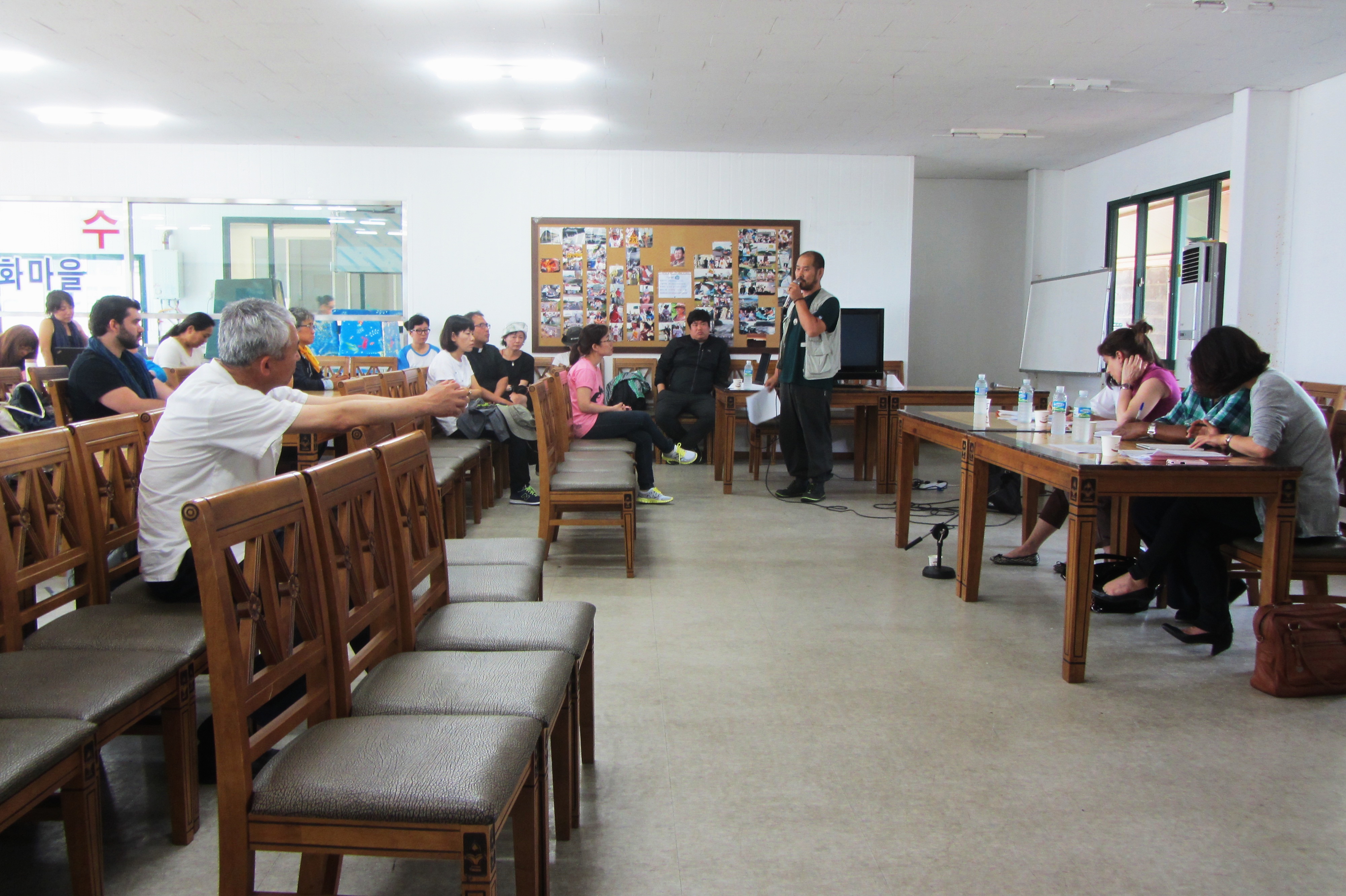
Village Anti-Base Committee Chairman, Goh Gwon-Il, begins the proceedings. The proceedings were emceed by Village Anti-Base Committee Chairman, Goh Gwon-Il who began giving a detailed overview of the history and facts of Gangjeong and the base project until now, such as the first fake vote and the second real vote where 94 percent of the 725 villagers in attendance voted against the base.
Descriptions of military, construction, and police harassment of villagers and activists followed. A video from 2011 of naval soldiers harassing and fighting with villagers was shown. Then a video of the 4-on-1 water assault on and beating of Dr. Song Kang-Ho by Coast Guard SSU Special Unite Divers in 2011. Next a video was shown of Villagers and activists attempted to climb a barge to talk to the workers and navy, and being beaten and pushed from the boat by workers and the navy.
Next videos were shown of the recent crackdown on the sit-in tents near the gate, including the near hanging on Mayor Kang by careless police and public workers, as well as the police pushing Villager Mi-Lyang off a 6 meter high ledge. Then Mi-Lyang, who is still in the hospital for recovery, came to give her testimony of the situation. It was clearly very difficult for her to speak of the recent traumatic event.

Villager Kim Mi-Lyang tells about her traumatic fall at the ends of the police. Then, Catholic Fr. Kim Sung-Hwan came to speak about and show videos of the oppression on the Catholics, including the near death of Father Mun in April of 2012 as well as the pushing over of Father Mun during communion destroying the sacraments, general police oppression and disruption of the daily catholic mass, including the outrageous use of pepper spray on those attending the mass.
Next, tangerine farmer and chairwoman of the Village Women’s Committee to Stop the Base, Jeong Young-Hee, came to talk about and show pictures and videos of further struggles and injuries from police violence as well as base construction pollution damage to crops. After that, Activist Bok-Hee came and talked about oppression on activists including the police and security thug violence at the construction gates, displaying the many injuries. She also emphasized the double standard, that when there are many cameras or visitors, the police are very gentle and polite but when no one is looking they are violent and rude. Next, Activist Youn-Ae came and gave a personal testimony about her life as an anti-base activist and oppression she has faced in Gangjeong.

Tangerine farmer and chairwoman of the Village Women’s Committee to Stop the Base, Jeong Young-Hee addresses the panel. Finally, Activist Sung-Hee came and talked about oppression on internationals, emphasizing detail the stories of Benjamin Monnet and Angie Zelter who were targeted and forcefully deported. She also talked about the recent re-entry denial of long-term Taiwanese Gangjeong resident, Emily Wang, as well as the more than 20 other entry denials and deportations related the anti-base struggle.
After the nearly two hours of detailed explanation by Gangjeong villagers and activists there was a general question and answer time. The UN visitors thanked the people for their testimonies and information and asked what kind of things they would like to see in the report, such as concrete statements or actions or resolutions. Although there wasn’t much time to comment 5 people responded with suggestions.
Finally, Margaret Sekaggya thanked everyone again and apologized for the short time. She also said she felt very well received and also thanked the organizers for organizing everything so well. In the end, she wished the people the best in their continued struggle. Then she went out for a short tour of the village before departure.
-
Morning with the Mayor | Organizing Notes
Reblogged with permission from: MORNING WITH THE MAYOR | by BRUCE K. GAGNON *
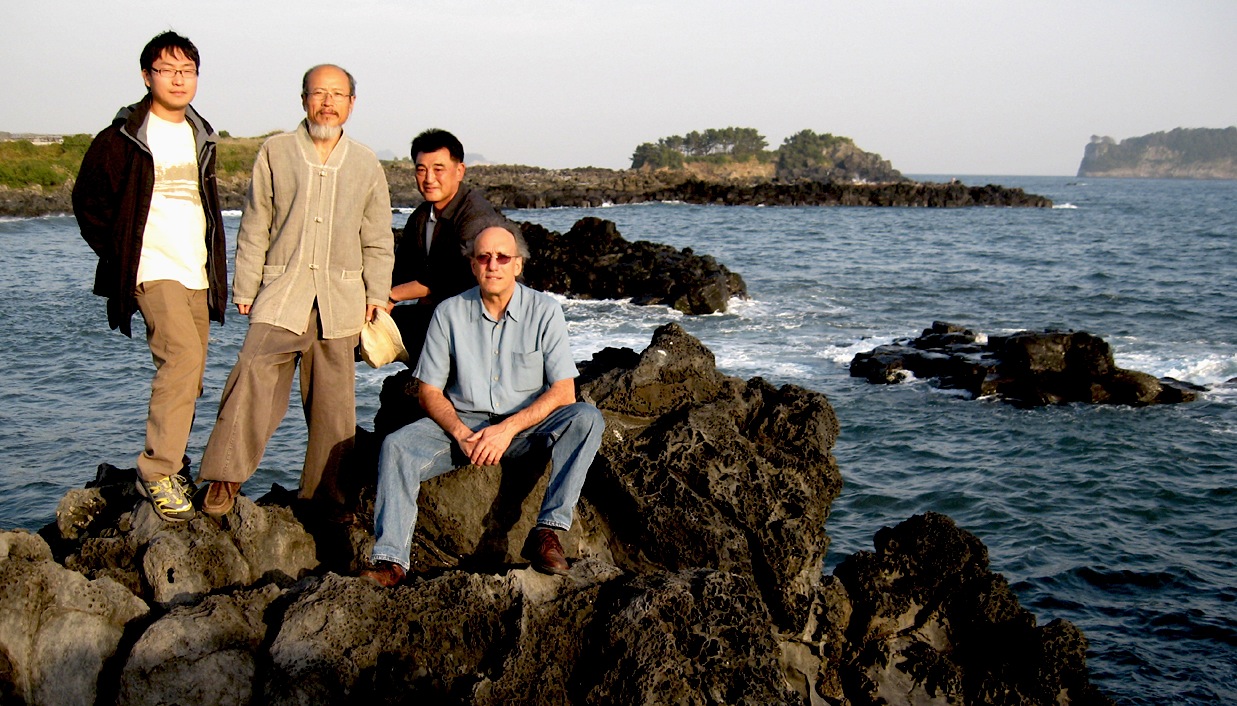
On my first trip to Gangjeong village Mayor Kang (just behind me in dark jacket) took me to see the place where the fresh water stream flows into the sea. This was to be one end of the massive Navy base now being built in the village. At that time I was able to see the undisturbed beauty of the coastline. I arrived in Berkeley, California last night about 7:30 pm and was able to join a group of conference participants at a Chinese restaurant where they were having dinner together. When Gangjeong village Mayor Kang saw me he rose and gave me a big hug. At that time there was no translator available so we didn’t get to have much conversation.
This morning at breakfast Mayor Kang arrived with a Korean professor from the university. The mayor had just come from doing an interview for Democracy Now which is supposed to air on Monday. Koohan Paik (Hawaii) was on the radio with the mayor. Koohan has been a great Jeju supporter and made it possible for the mayor to speak at this event on behalf of the village.
During breakfast the mayor told me that when I first came to visit Gangjeong he remembers me talking about space technology. He told me that he now understands much better what I was saying. He said he believes that the US is bringing the South Korean government into the military space program as a junior partner to help control China. I was happy to hear that he has put all the pieces together.
A translator took the mayor and I for a long stroll through the vast University of California campus. We went to the top of a huge bell tower that enabled us to see the entire San Francisco bay area. While we were looking out over the bay I told the mayor how much their non-violent resistance has inspired people all over the world due to their strong spiritual grounding. He told me that they made a conscious decision to act in that way to help them deal with the obvious depression and sadness that comes from the Navy base construction project. He said that if they were going to resist then they had to find a way to stay connected to what was good in nature and in each other. He offered to teach me the dances…
*Reblogged posts do not necessarily reflect the opinions or views of Save Jeju Now
-
“Police, if you move this altar, the world will watch over you”

Photo by Save Jeju Now (Source)/ Father Woo holds an Eucharist on May 3. For all 30 photos, see the source. “Policemen, if you move this altar, 1 billion Catholic followers all over the world will watch over you.” The young Father Woo from Jeju finished ALL the orders of the Catholic mass despite the repeated remarks by Koo Seul-Hwan, security director of the Seogwipo Police Station, who was embarrassed but continued to threaten him that it is an obstruction of business.
It was for the first time that an altar was set up in front of the main naval base construction(destruction) gate since the navy forcefully set up fence on the way to the Gureombi Rock on Sept. 2, 2011.
Kim Mi-Lyang, a woman villager, held up a sign that reads, “Return back the Gureombi Rock to Kim Mi-Lyang, daughter of Gangjeong!” After the mass, we could observe an elderly follower teared and hugged Fr. Mun Jeong-Hyeon. There were lots of woman followers. It was really moving that they danced the Gangjoeng addictive dance together with the peacekeepers in Gangjeong.
Please see the video made by the Peace Nomad and Fr. Mun Jeong-Hyeon’s writing on the meaning of mass in front of gate, here. See also Organizing Notes, here.
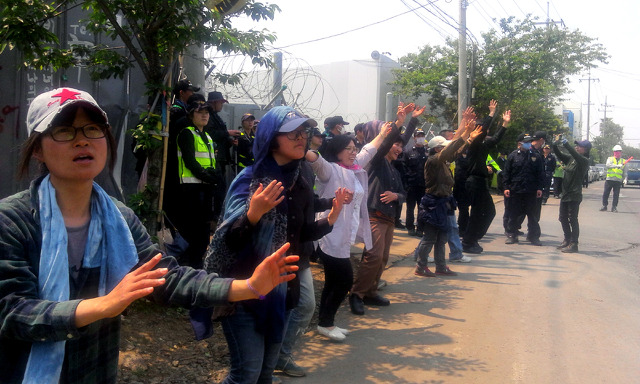
Photo by Save Jeju Now/ Catholics dancing after the mass together with the peacekeepers in Gangjeong on May 3 It was April 8 that the construction company thugs blocked the gates then on April 25, Kang Un-Sik, a new chief of the Seogwipo Police Station, fostered threatening mood with his military boots and mobilization of 800 policemen who occupied the two gates. A police unit were searching village to arrest people.
It has become already four prisoners this year, including Yang Yoon-Mo, Park Sung-Soo (released on April 1), Kim Young-Jae, and Lee Jong-Hwa. The people’s press conferences led by the Jeju Pan-Island Committee for the Stop of Military Base and for the Realization of Peace Island on April 10 and National Network of Korean Civil Society for Opposing to the Naval Base in Jeju Island on May 2, were oppressed respectively.
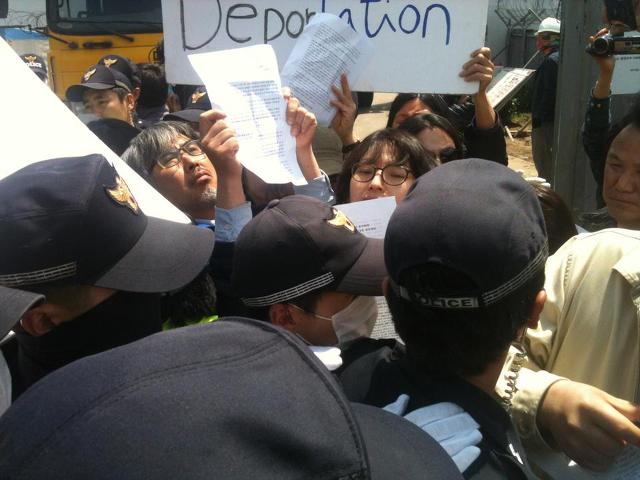
Photo by Park Young-In on May 2 (Source) / People’s legal press conference to denounce government’s abuse of state power in front of gate at 1 pm was even interrupted by the police. For more on the day’s photos by Park Young-In and Kang Eun-Joo, see the source. The press conference on May 2 was to demand the stop of illegal construction (destruction) and to criticize the government’s recent abuse of state power- indiscriminate arrest, imprisonment, and deportation of people. In Korea, press conference can be legally held without report. However, the police removed people twice to allow the construction trucks to pass by, despite people’s demand for time and protest to it.
The National Assembly has passed about 200.9 billion won budget for the 2013 Jeju naval base project on Dec. 31, 2012. Why does the government enforce illegal destruction that is already tremendous violation of EIA and human rights? Is it because of Samsung that gets 108.3 billion won for caisson production & stationing and basic formation of breakwater in the 1st work area of the project? See here.
The police interrupt people’s press conference to denounce the abuse of state power ( Video by Go Gwon-Il on May 2)
The peacekeepers who have kept the gates day and nights have been at the risk of worsening health, arrest and imprisonment. Wang Yu-Hsuan who has acted in Gangjeong for a long time has become the 21st victim of ROK government’s entry denial, in relation to naval base issue.
Mass that has been daily continued got oppression, as well as life and peace 100 bows. Even though the article 20 of the South Korea Constitution protects the freedom of religion.
However, the exemplar struggle by the Catholic Fathers, Brothers, Sisters and followers in Gangjeong is raising a new beacon of hope in the struggle against the Jeju naval base construction(destruction).
The Fathers’ struggle risks their own dignity as human beings and priests.

Photo by Pang Eun Mi on April 30/ Catholic Fathers are encircled during the mass in front of naval base construction gate to stop construction (destruction) trucks. For more photos, see here. 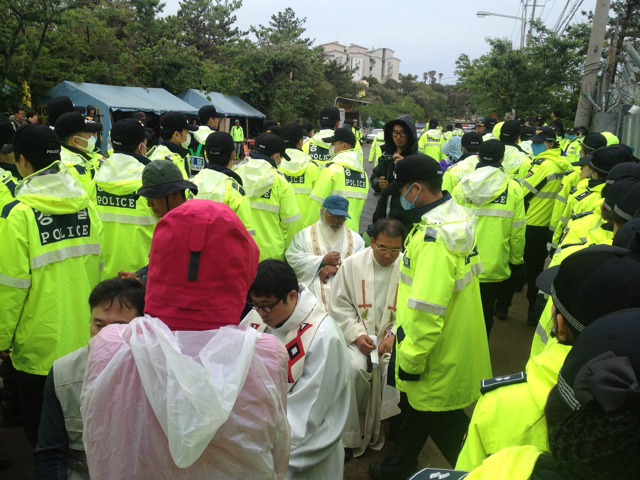
Photo by Pang Eun-Mi on April 30/ Catholic Fathers are encircled when they take a mass in front of naval base construction gate to stop construction (destruction) trucks. (Source) 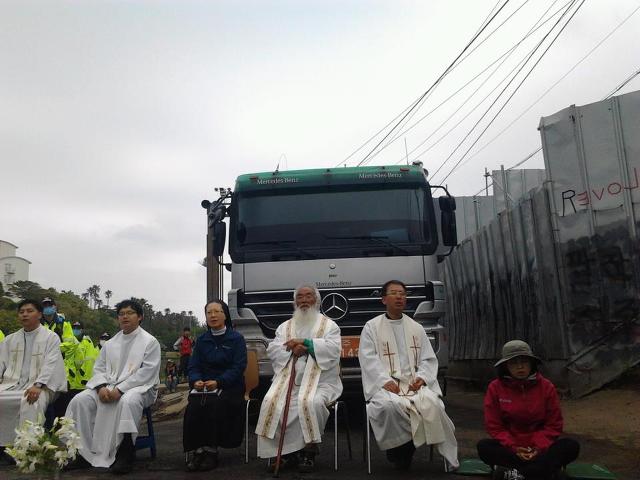
Photo by Leejesu on April 29/ Catholic Fathers block destruction trucks Heart-breaking struggle by Catholic Fathers and Jeju Island people continues while hymns are sung (Video by Pang Eun-Mi on May 2 : Source)
However, isn’t it amazing to imagine all the Fathers, Brothers, and Sisters, in Korea appear in front of the gate to express opposition against the Jeju naval base and will for the true Peace Island?
Such possibility has been shown when lots of Fathers and Sisters from the Jeju stood in front of destruction area and danced together. On the day, you could say The Holy Spirit has arrived in the village.

Photo by Leejesu on April 29 (Source)/Fathers and sisters stand together in front of destruction gates to hold a holy mass. Dancing Fathers and Sisters (Video by Leejesu on April 29)
Update on May 4: Is it because of Fathers’ strong protests including the setting of altar on May 3? On Saturday, May 4, trucks did not pass by the main gate during the 11 am mass. It could be for a short time. But Fathers’ struggle is very appreciated. Here are some photos of Fathers, Brothers, Sisters and Catholic followers who pray and meditate during the mass. The big brother, Samsung is looking over the field in the form of a big monitor. The police with ‘red hats,’ with the background of fence where people left resistance slogans are decorations of the world where people’s aspiration for peace and democracy is urgent. For more photos, see here. The 1st photo is by Pang Eun-Mi. The others are by Save Jeju Now.
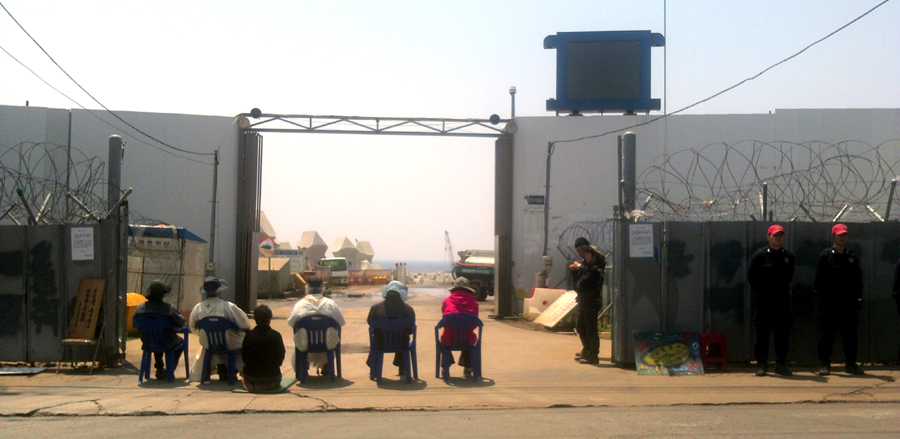
Photo by Save Jeju Now (source)/ Trucks do not pass by the main gate during the morning mass on May 4.

